Tricholoma equestre (L.) P. Kumm. - Yellow Knight
Tricholoma equestre (L.) P. Kumm. - Yellow Knight
Phylum: Basidiomycota - Class: Agaricomycetes - Order: Agaricales - Family: Tricholomataceae
Distribution - Taxonomic History - Etymology - Identification - Culinary Notes - Reference Sources
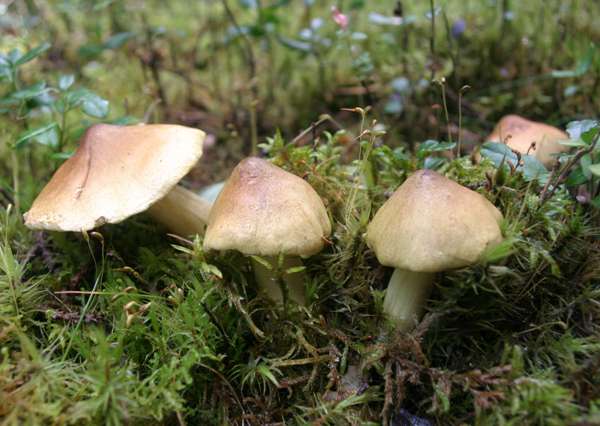
Despite a visual similarity to the Sulphur Knight, this chunky mushroom is easily distinguished by its smell: it has none. Tricholoma equestre (syn. Tricholoma flavovirens) is also known as the Man on Horseback; why that should be is a mystery.
Distribution
Common in northern Scotland, under Scots Pine in sandy areas but also occasionally with birches and with oaks, this late season mushroom is rarely seen in southern Britain and in Ireland.
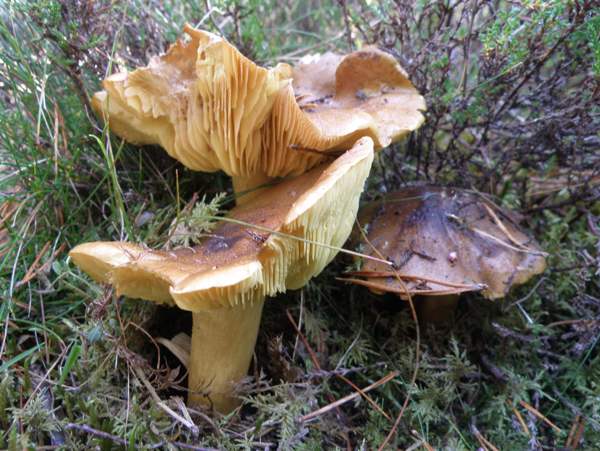
Taxonomic history
Carl Linnaeus described this striking mushroom in the second volume of his Species Plantarum of 1753, wherein he named it Agaricus equestris. (Most gilled fungi were in those days placed into a gigantic Agaricus genus, since made more manageable by redistributing most of its contents to other new genera.)
It was the German mycologist Paul Kummer who, in 1871, transferred this species to the genus Tricholoma, thus creating its current binomial Tricholoma equestre.
Synonyms of Tricholoma equestre include Agaricus equestre L., Agaricus auratus Paulet,
Agaricus flavovirens Pers.,Tricholoma equestre var. equestre (L.) P. Kumm.,Tricholoma auratum (Paulet) Gillet, and Tricholoma flavovirens (Pers.) S. Lundell.
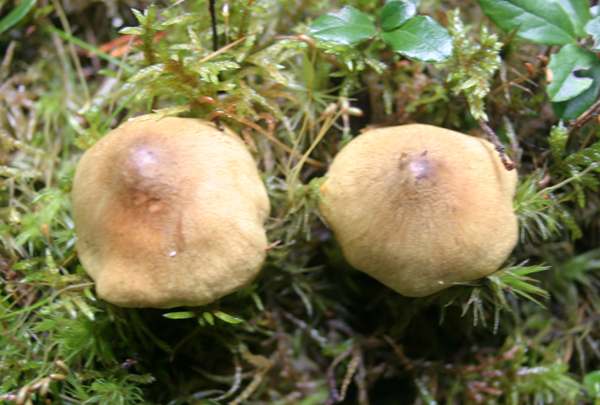
Etymology
Tricholoma was established as a genus by the great Swedish mycologist Elias Magnus Fries. The generic name comes from Greek words meaning 'hairy fringe', and it must be one of the least appropriate mycological genus names, because very few species within this genus have hairy or even shaggily scaly cap margins that would justify the descriptive term.
As a specific epithet the term equestre is not quite so difficult to unscramble; it is to do with horse riding. Look at the mushrooms in the picture above and you will see that they have opened up to become saddle shaped... well, some of them do... a bit!
Identification guide
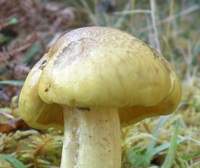 |
CapBright yellow, with a fibrous or scaly olive-brown central area; convex, often with a wavy margin and a slight central umbo; 5 to 9cm across. The flesh is white or very pale yellow. |
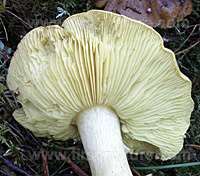 |
GillsPale to right yellow; adnexed (often with a notch). StemPale yellow; lined vertically with brown fibres; cylindrical; 5 to 10cm long, 0.8 to 1.5cm diameter; no ring. |
SporesEllipsoidal, smooth, 5-8.5 x 3-6µm, with a pronounmced hilar appendage; inamyloid. Spore printWhite. |
|
Odour/taste |
No significant odour. Tasting not advisable: several cases of severe poisoning have been confirmed as being the result of eating, over a period of several days, meals each containing moderate portions of these mushrooms. |
Habitat & Ecological role |
Mainly under pines, but also mycorrhizal with birches and occasionally oaks. |
Season |
July to October in Britain and Ireland; earlier in Scandinavia and rather later in southern Europe. |
Similar species |
Tricholoma sulphureum has a yellow cap without the brown-olive central area; it smells strongly of coal gas. |
Culinary Notes
Although reported in some field guides to be edible and very tasty, and indeed having been sold as such throughout much of mainland Europe until recently, the Yellow Knight is now known to be toxic and should definitely not be collected for the pot. The poisonous chemicals in these fungi have not been definitely isolated, but several cases of painful muscle damage have been attributed to eating these chunky fungi.
Reference Sources
Fascinated by Fungi, 2nd Edition, Pat O'Reilly 2016, reprinted by Coch-y-bonddu Books in 2022.
R Bedry et al, New England Journal of. Medicine., 2001, 345, 798 (DOI: 10.1056/nejmoa010581)
Kibby, G (2013) The Genus Tricholoma in Britain, published by Geoffrey Kibby
Dictionary of the Fungi; Paul M. Kirk, Paul F. Cannon, David W. Minter and J. A. Stalpers; CABI, 2008
Taxonomic history and synonym information on these pages is drawn from many sources but in particular from the British Mycological Society's GB Checklist of Fungi.
Fascinated by Fungi. Back by popular demand, Pat O'Reilly's best-selling 450-page hardback book is available now. The latest second edition was republished with a sparkling new cover design in September 2022 by Coch-y-Bonddu Books. Full details and copies are available from the publisher's online bookshop...

